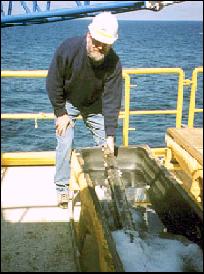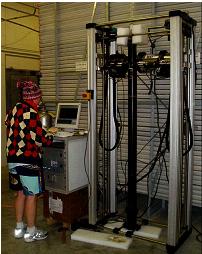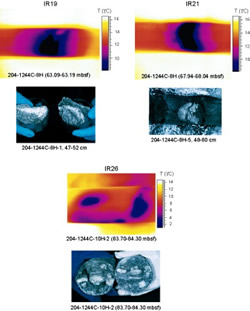In addition to the information provided here, a full listing of project related publications and presentations as well as a listing of funded students can be found in the Methane Hydrate Program Bibliography [PDF]. Phase I Final Report [PDF-2.75MB]
Phase II Final Report [PDF-1.82MB]
Fire in the Ice - Article on ODP Leg 204
In-Situ Sampling and Characterization of Naturally Ocurring Marine Methane Hydrate - ODP Leg 204 [PDF-358KB] - October 2003
Peer-Reviewed Publications
Bangs, N., R. Musgrave, and A. Tréhu, 2005, Upward shifts in the southern Hydrate Ridge gas hydrate stability zone following postglacial warming, offshore Oregon, Journal of Geophysical Research, Vol. 110, B03102, doi:10.1029/2004JB003293.
Janik, A., D. Goldberg, G. Guerin, and T. Collett, in review, Estimation of gas hydrate concentration and heterogeneity on Cascadia Margin from ODP 204 logging while drilling (LWD) measurements, in Collett, T., A .Johnson, C. Knapp and R. Boswell, eds., Natural Gas Hydrates: Energy Resource and Associated Geologic Hazards, The American Association of Petroleum Geologists Hedberg Special Publication.
Johnson, J., C. Goldfinger, N. Bangs, A. Trehu, and J. Chevallier, in review, Structural vergence variation and clockwise block rotation in the Cascadia accretionary wedge, offshore Oregon, Tectonics.
Kim, D., T. Uhm, H. Lee, Y. Lee, B. Ryu, and J.Kim, in review, Compositional and structural identification of natural gas hydrates collected at Site 1249 on ODP Leg 204, Korean Journal of Chemical Engineering.
Liu, X., and P. Flemings, 2006, Passing gas through the hydrate stability zone at southern Hydrate Ridge, offshore Oregon, Earth and Planetary Science Letters, 241, p. 211-226.
Liu, X., and P. Flemings, in review, Dynamic multi-phase flow model of hydrate formation in marine sediments, Journal Geophysical Research.
Long, H., P. Flemings, and J. Germaine, in review,Interpreting in-situ pressure and hydraulic properties with borehole penetrometers in ocean drilling: DVTPP and piezoprobe deployments at southern Hydrate Ridge, offshore Oregon, Journal Geophysical Research.
Milkov, A., G. Claypool, Y. Lee, and R. Sassen, 2005, Gas hydrate systems at Hydrate Ridge offshore Oregon inferred from molecular and isotopic properties of hydrate-bound and void gases, Geochim. Cosmochim. Acta, Volume 69, p. 1007-1026.
Milkov, A., G. Claypool, Y. Lee, M. Torres, W. Borowski, H. Tomaru, R. Sassen, P. Long, and the ODP Leg 204 Scientific Party, 2004, Subsurface gases indicate gas hydrate occurrence in marine sediments at southern Hydrate Ridge offshore Oregon, Org. Geochem., Volume 35, p. 1067-1080.
Milkov, A., G. Claypool, Y. Lee, W. Xu, G. Dickens, W. Borowski, and the ODP Leg 204 Scientific Party, 2003, In situ methane concentrations at Hydrate Ridge offshore Oregon: new constraints on the global gas hydrate inventory from an active margin, Geology, Volume 31, p. 833-836.
Milkov, A., G. Dickens, G. Claypool, Y. Lee, W. Borowski, M. Torres, W. Xu, H. Tomaru, A. Tréhu, and P. Schultheiss, 2004, Co-existence of gas hydrate, free gas, and brine within the regional gas hydrate stability zone at Hydrate Ridge (Oregon Margin): evidence from prolonged degassing of a pressurized core, Earth and Planetary Science Letters, Volume 222, p. 829-843.
Musgrave, R., N. Bangs, J. Larrasoaña, E. Gràcia, J. Hollamby, and M. Vega, 2006, Rise of the base of the gas hydrate zone since the last glacial recorded by rock magnetism, Geology, 34, p.117-120.
Riedel, M., P. Long, and T. Collett, 2006, Estimates of in situ gas hydrate concentration from resistivity monitoring of gas hydrate bearing sediments during temperature equilibration, Marine Geology, Volume 227, p. 215-225.
Riedel, M., T. Collett, M. Malone, and the IODP Expedition 311 Scientists, 2006. Proc. IODP, 311, Washington, DC (Integrated Ocean Drilling Program Management International, Inc.), doi:10.2204/iodp.proc.311.
Riedel, M., T. Collett, M. Malone, and the IODP Expedition 311 Scientists, 2006, Stages of gas-hydrate evolution on the northern Cascadia margin, Scientific Drilling Journal, Vol. 3, pp.18-24, doi:10.2204/iodp.sd.3.04.
Riedel, M., T. Collett, M. Malone, F. Akiba, M. Blanc-Valleron, M. Ellis, G. Guerin, Y. Hashi-Moto, V. Heuer, Y. Higashi, M. Holland, P. Jackson, M. Kaneko, M. Kastner, J. Kim, H. Kitajima, P. Long, A. Malinverno, G. Myers, L. Palekar, J. Pohlman, P. Schultheiss, B. Teichert, M. Torres, A. TréHu, J. Wang, U. Wortmann, and H. Yoshioka, 2006, Gas hydrate transect across northern Cascadia Margin, Eos, Volume 87, N. 33, p. 325-330-332.
Riedel, M., P. Long, C. Liu, P. Schultheiss, T. Collett, and ODP Leg 204 Shipboard Scientific Party, 2006, Physical properties of near-surface sediments at southern Hydrate Ridge: results from ODP Leg 204, in Tréhu, A., Bohrmann, G., Torres, M., and Colwell, F. eds., Proceedings of ODP, Scientific Results, Vol. 204, pp.1-29, doi:10.2973/odp.proc.sr.204.104.
Riedel, M., E. Willoughby, R. Hyndman, G. Spence, N. Chapman, R. Edwards, I. Novosel, and K. Schwalenberg, in review, Gas hydrates at the Northern Cascadia Margin, in Collett, T., A. Johnson, C. Knapp and R. Boswell, eds., Natural Gas Hydrates: Energy Resource and Associated Geologic Hazards, The American Association of Petroleum Geologists Hedberg Special Publication.
Riedel, M., E. Willoughby, M. Chen, T. He, I. Novosel, K. Schwalenberg, R. Hyndman, G. Spence, in review, Gas hydrate on the Northern Cascadia Margin: regional geophysics and structural framework, in Collett, T., A. Johnson, C. Knapp and R. Boswell, eds., Natural Gas Hydrates: Energy Resource and Associated Geologic Hazards, The American Association of Petroleum Geologists Hedberg Special Publication.
Teichert, B., G. Bohrmann, and E. Suess, 2005, Chemoherms on Hydrate Ridge—Unique microbially-mediated carbonate build-ups growing into the water column, Palaeogeogr., Palaeoclim, Palaeoecol., Volume 227, p. 67-85.
Teichert, B., M. Torres, G. Bohrmann, and A. Eisenhauer, 2005, Fluid sources, fluid pathways and diagenetic reactions across an accretionary prism revealed by Sr and B geochemistry, Earth and Planetary Science Letters, Volume 239, p. 106-121.
Torres, M., B. Teichert, A. Tréhu, W. Borowski, and H. Tomaru, 2004, Relationship of pore water freshening to accretionary processes in the Cascadia margin: Fluid sources and gas hydrate abundance, Geophysical Research Letters, Vol. 31, L22305, doi:10.1029/2004GL021219.
Torres, M., K. Wallmann, A. Tréhu, G. Bohrmann, W. Borowski, and H. Tomaru, 2004, Gas hydrate growth, methane transport, and chloride enrichment at the southern summit of Hydrate Ridge, Cascadia Margin off Oregon, Earth and Planetary Science Letters, Volume 226, p. 225-241.
Tréhu, A., G. Bohrmann, F. Rack, M. Torres, and the ODP Leg 204 Scientific Party, 2003, ODP Leg 204: gas hydrate distribution and dynamics beneath southern Hydrate Ridge, JOIDES Journal, Volume 29(2), p. 5-8.
Tréhu, A., P. Flemings, N. Bangs, J. Chevallier, E. Gràcia, J. Johnson, C. Liu, X. Liu, M. Riedel, and M. Torres, 2004, Feeding methane vents and gas hydrate deposits at south Hydrate Ridge, Geophysical Research Letters, Vol. 31, L23310, doi:10.1029/2004GL021286.
Tréhu, A., P. Long, M. Torres, G. Bohrmann, F. Rack, T. Collett, D. Goldberg, A. Milkov, M. Riedel, P. Schultheiss, N. Bangs, S. Barr, W. Borowski, G. Claypool, M. Delwiche, G. Dickens, E. Gràcia, G. Guerin, M. Holland, J. Johnson, Y. Lee, C. Liu, X. Su, B. Teichert, H. Tomaru, M. Vanneste, M. Watanabe, and J. Weinberger, 2004, Three-dimensional distribution of gas hydrate beneath southern Hydrate Ridge: constraints from ODP Leg 204, Earth and Planetary Science Letters, Volume 222, p.845-862.
Weinberger, J., K. Brown, and P. Long, 2005, Painting a picture of gas hydrate distribution with thermal images, Geophysical Research Letters, Vol. 32, L04609, doi:10.1029/2004GL021437.
Other Publications
Collett, T., S. Barr, D. Goldberg, and G. Guerin, 2003, Downhole logging, in Trehu, A., G. Bormann, and R. Colwell, eds., Initial Reports—Gas hydrate beneath the seafloor of Hydrate Ridge: Proceedings of the Ocean Drilling Program, Ocean Drilling Program, Texas A&M University, College Station, TX, Volume 204, available online (click here [external site]).
Riedel, M., T. Collett, M. Malone, and the IODP Expedition 311 Scientists, 2006, Proceedings of the Integrated Ocean Drilling Program Expedition 311, Cascadia Margin Gas Hydrates, published by IODP Management International, Inc., for the Integrated Ocean Drilling Program, prepared by U.S. Implementing Organization Science Services, Texas A&M University, available online (click here [external site]).
Shipboard Scientific Party, 2005, Integrated Ocean Drilling Program, Expedition 311 Preliminary Report, Cascadia Margin Gas Hydrates, available online (click here [external site]).
Tréhu, A., G. Bohrmann, F. Rack, M. Torres, and et al., 2003, ., Initial Reports—Gas hydrate beneath the seafloor of Hydrate Ridge: Proceedings of the Ocean Drilling Program, Ocean Drilling Program, Texas A&M University, College Station, TX, Volume 204, available online (click here [external site]).
Winters, W., W. Waite, D. Mason, L Gilbert, 2006, Physical properties of repressurized sediment from Hydrate Ridge, in Tréhu, A., G. Bohrmann, M. Torres, F. Colwell, eds., Proc. ODP, Sci. Results, 204: College Station, TX (Ocean Drilling Program), 1–19. doi:10.2973/odp.proc.sr.204.119.2006, available online (click here [external site]).
Presentations
Cespedes, N., A. Trehu, and M. Torres, 2006, Grain size variation of sediments from Expedition 311, paper OS33B-1714, San Francisco, CA, American Geophysical Union Fall Meeting, December 11-15.
Collett, T., M. Riedel, and M. Malone, 2006, Gas Hydrate Research Coring and Downhole Logging Operational Protocol, paper OS11E-02, San Francisco, CA, American Geophysical Union Fall Meeting, December 11-15.
Collett, T., D. Goldberg, A. Janik, and G. Guerin, 2004, Occurrence of Gas Hydrate and Associated Free-Gas Accumulations on Hydrate Ridge, Offshore Oregon, Dallas, TX, The American Association of Petroleum Geologists Annual Meeting, April 18-21.
Cook, A., and D. Goldberg, 2006, Strength of Gas Hydrate-bearing Sediments from IODP Expedition 311, Cascadia Margin, paper OS33B-1700, San Francisco, CA, American Geophysical Union Fall Meeting, December 11-15.
Enkin, R., J. Baker, L. Esteban, A. Mullin, B. Paterson, T. Hamilton, and M. Riedel, 2006, Magnetic Properties of Sediments from IODP Expedition 311 - Cascadia Margin Gas Hydrates: Records of Fossil Sulphate Methane Interface?, paper OS33B-1692, San Francisco, CA, American Geophysical Union Fall Meeting, December 11-15.
Francis, T., 2004, The HYACINTH Project - Pressurized Samples from the Seabed for Continental Margin Research, Dallas, TX, The American Association of Petroleum Geologists Annual Meeting, April 18-21.
Goldberg, D., G. Guerin, A. Malinverno, K. Tagbor, and J. Alford, 2006, Formation Vp Derived From LWD Sonic Data at IODP Sites U1325-U1329, Cascadia Margin, paper OS33B-1713, San Francisco, CA, American Geophysical Union Fall Meeting, December 11-15.
Guerin, G., and D. Goldberg, 2006, Analysis of Multimode Acoustic Waveforms in Gas Hydrate Bearing Sediments, IODP Expedition 311, Cascadia Margin, paper OS33B-1701, San Francisco, CA, American Geophysical Union Fall Meeting, December 11-15.
Holland, M., P. Schultheiss, J. Roberts, and M. Druce, 2006, Gas Hydrate-Sediment Morphologies Revealed by Pressure Core Analysis, paper OS33B-1689, San Francisco, CA, American Geophysical Union Fall Meeting, December 11-15.
Lu, H., I. Moudrakovski, J. Schicks, J. Ripmeester, and M. Zhang, 2006, The characteristics of gas hydrates recovered from Northern Cascadia margin by IODP Expedition 311, paper OS11E-08, San Francisco, CA, American Geophysical Union Fall Meeting, December 11-15.
Lu, Z., 2006, Iodine and bromine concentrations in pore waters from two gas hydrate fields: IODP 311 and ODP 204, paper OS11E-07, San Francisco, CA, American Geophysical Union Fall Meeting, December 11-15.
Malinverno, A., M. Kastner, M. Torres, and U. Wortmann, 2006, Gas Hydrate Saturations and Their Uncertainties From Chlorinity and Well Log Data at IODP Site U1325 (Exp. 311, Cascadia Margin), paper OS11E-04, San Francisco, CA, American Geophysical Union Fall Meeting, December 11-15.
Pasteris, J., 2003, Development of In-Situ, Real-Time Raman Analysis of Clathrate Hydrates on the Sea Floor, Seattle, WA, Geological Society of America Annual Meeting, November 2-5.
Paulson, M., J. Merrill, K. Moran, C. Baxter, and J. Ressler, 2006, Predicting Sediment Strength in Accretionary Complexes Using Geophysical Logs, paper T21A-0388, San Francisco, CA, American Geophysical Union Fall Meeting, December 11-15.
Pinero, E., F. Martinez-Ruiz, E. Gracia, J. Larrasoana, and J. Danobeitia, 2006, Gas Hydrates-bearing Sediments from Southern Hydrate Ridge (ODP Leg 204): Geochemical and Mineralogical Approach, paper OS33B-1694, San Francisco, CA, American Geophysical Union Fall Meeting, December 11-15.
Pohlman, J., M. Kaneko, V. Heuer, R. Plummer, and R. Coffin, 2006, Molecular and Isotopic Characterization of Gases from IODP Expedition 311: Source and Gas Hydrate Related Controls, paper OS11E-06, San Francisco, CA, American Geophysical Union Fall Meeting, December 11-15.
Riedel, M., T. Collett, M. Malone, R. Hyndman, E. Willoughby, G. Spence, R. Chapman, N. Edwards, and K. Schwalenberg, 2006, IODP Expedition 311 – A review of gas hydrate research on the Northern Cascadia Margin, paper OS11E-01, San Francisco, CA, Americana Geophysical Union Fall Meeting, December 11-15.
Riedel, M., T. Collett, M. Malone, and Expedition 311 Scientific Party, 2005, Integrated Ocean Drilling Program Expedition 311— Cascadia Margin Gas Hydrates, San Francisco, CA, American Geophysical Union Fall Meeting, December 5-9.
Riedel, M., T. Collett, M. Malone, and Expedition 311 Scientific Party, 2006, Integrated Ocean Drilling Program Expedition 311—Cascadia Margin Gas Hydrates, International Conference on Sediment-hosted gas hydrates: new insights on natural and synthetic systems, Geological Society of London, January 25-26.
Schicks, J., M. Ziemann, R. Naumann, and J. Erzinger, 2006, Characterization of Gas Hydrate Samples from IODP 311 using High Resolution Raman Spectroscopy, X-ray Diffraction and Differential Scanning Calorimetry, paper OS33B-1698, San Francisco, CA, American Geophysical Union Fall Meeting, December 11-15.
Stern, L., and S. Kirby, 2006, Natural gas hydrate in sediments imaged by cryogenic SEM: Insights from lab experiments on synthetic hydrates as interpretive guides, paper OS33B-1699, San Francisco, CA, American Geophysical Union Fall Meeting, December 11-15.
Teichert, B., G. Bohrmann, E. Gràcia, J. Johnson, X. Su, J. Weinberger, and ODP Leg 204 Shipboard Scientific Party, 2003, Authigenic carbonates from Hydrate Ridge (ODP Leg 204), formation processes and evidence of fluid pathways, Nice, France, EGS-AGU-EUG Joint Assembly, April 6-11.
Teichert, B., G. Bohrmann, E. Gràcia, J. Johnson, X. Su, J. Weinberger, and ODP Leg 204 Shipboard Scientific Party, 2003, Authigenic carbonates from Hydrate Ridge (ODP Leg 204), IODP-ICDP, Mainz, Germany, March 26-28.
Teichert, B., G. Bohrmann, M. Torres, and A. Eisenhauer, 2004, Fluid pathways influencing gas hydrate occurrence at Hydrate Ridge, Bremen, Germany, Euro-Forum for Scientific Earth Drilling, March 17-19.
Teichert, B., M. Torres, G. Bohrmann, and A. Eisenhauer, 2005, Fluid sources, fluid pathways and diagenetic reactions across an accretionary prism revealed by Sr and B geochemistry, Potsdam, Germany, ICDP-IODP meeting, March 14-16.
Trehu, A., 2006, Heat flow in the outer Cascadia accretionary complex from boreholes and BSRs, paper OS33B-1715, San Francisco, CA, American Geophysical Union Fall Meeting, December 11-15.
Villinger, H., M. Heesemann, A. Fisher, A. Trehu, and S. Witte, 2006, Deployment and Testing of the Third-generation Tool to Determine In-situ Temperatures While Piston Coring During Scientific Ocean Drilling, paper OS31D-1664, San Francisco, CA, American Geophysical Union Fall Meeting, December 11-15.
Wang, J., 2006, The Lithological Constraint to Gas Hydrate Formation: Evidence of Grain Size of Sediments from IODP 311 on Cascadia Margin, paper OS33B-1708, San Francisco, CA, American Geophysical Union Fall Meeting, December 11-15.
Xu, W., 2006, The Role of Natural Gas Hydrates in Shaping the Global Continental Slopes, paper OS12C-07, San Francisco, CA, American Geophysical Union Fall Meeting, December 11-15.






